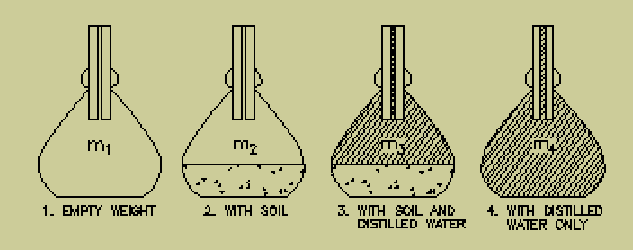Aim: For determination of specific gravity of the solids by density bottle method
Theory
The specific gravity of solid particles refers to the proportion of the mass density of solids to the proportion of water. Its determination is carried out in the laboratory by applying the relation:
![]()
Where,
M1 = mass of empty bottle
M2 = mass of the bottle and dry soil
M3 = mass of bottle, soil and water
M4 = mass of bottle filled with water only.
Tool and equipment
- Vacuum desiccator
- Vacuum pump
- Weighing balance accuracy 0.001g
- Spatula
- Constant temperature water bath (270C)
- Oven (105 0 to 110 0C)
- 50ml density bottle with stopper
Process
1. Thoroughly clean the density bottle and leave to dry it in an oven at the approximate temperature105 0C to 100 0C. After that, leave it for cooling in the desiccator.
2. Measure the bottle, with help of a stopper to the closest 0.001g (M1).
3. Now take around 5 to 10g of the oven dried soil specimen and relocate it the density bottle. Measure the weight of the bottle once again with the stopper and also measure the weight of dry sample (M2).
4. Put de-aired distilled water to the density bottle just simply adequate to protect the soil. Shake it mildly to blend the soil and water.
5. Position the bottle holding the soil and water after eliminating the stopper in the vacuum desiccator.
6. Vacate the desiccator slowly by functioning the vacuum pump. Decrease the weight to at least 20 mm of mercury. Now put it in the bottle in the desiccator for minimum 60 minutes or more than that until no additional movement of air is observed.
7. Substitute the vacuum and confiscate the top of the desiccator. Stir the soil in the bottle carefully with a spatula. Before removing the spatula from the bottle, the particles of soil adhering to it should be washed off with a few drops of air free water. Replace the lid of the desiccator and once again exert vacuum. Carry on the process again and again unless there is no more air is advanced from the sample.
Note: In those cases, when the vacuum desiccator is not readily accessible, the entrapped air could be eliminated by process of heating the density bottle on sand or water bath as per the need.
8. Confiscate the bottle from the desiccator. Augment air-free water up to the brim until the bottle is full. Inset the stopper.
9. Dip the bottle till the neck in a uniform-temperature bath for roughly 1 hour or till the point where it has achieved the uniform temperature.
In those case where there is a visible reduction in the size of the liquid in the vessel, get rid of the stopper and put more water to the vessel and substitute the stopper. Once again, position the vessel in the water bath. Allocate ample amount of time to make sure that the bottle and its content reach the uniform temperature.
10. Now, pull out the bottle from the water bath. Wipe it thoroughly and dry it from outside as well. Fill up the capillary in the stopper with droplets of distilled water, if the need arises.
11. Assess the weight of the bottle and its insides (M3).
12. Empty the contents of the bottle and clean it methodically. Fill it uptp the brim with distilled water. Inset the stopper.
13. Submerge the bottle in the uniform-temperature bath for approximately 60 minutes or until it has reached the uniform temperature of the bath.
In those case, where there is a visible decrement in the capacity of the liquid, eliminate the stopper and put more water. Once again immerse it in the water bath.
14. Remove the bottle from the water bath. Wipe it till it is completely dry and measure the mass (M4).
Observations and Calculations:
| Sl. No. | Observations an Calculations | Determination No. | ||
| 1 | 2 | 3 | ||
| Observation | ||||
| 1 | Density bottle No. | |||
| 2 | Mass of empty density bottle (M1) | |||
| 3 | Mass of Mass of bottle dry soil (M2) | |||
| 4 | Mass of bottle, soil and water (M3) | |||
| 5 | Mass of bottle filled with water (M4) | |||
| Calculations | ||||
| 6 | M2 – M1 | |||
| 7 | M3 – M4 | |||
| 8 | Calculate G using formula | |||
Result:
Specific gravity of solids=

